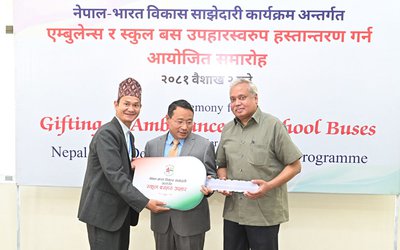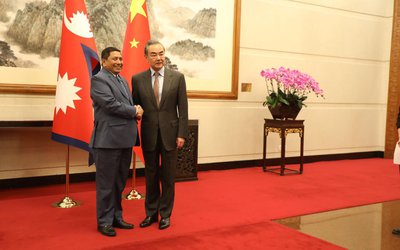
With the slow response of the government towards reconstruction and rehabilitation, desperate earthquake victims have launcheda drive on their own to constructthe temporary shelters before the onset of monsoon. Although the government announced a package of Rs.15, 000.00 per family, nobody knows when the money will be distributed to them. Backed by civil society organizations like NGOs, INGOs, youth wings or students unions, individual donors from within the country and outside,the needy people have startedbuilding theirtemporary shelters. Although the United Nations has called for 349 million dollars for managing three months of temporary settlement, it received less than 15 percent of the amount. In the present scenario with virtually no funds, the onset of monsoon will definitely bring more hardship for the earthquake victims.The campaign of building temporary shelters is impossible without the involvement of the government and Nepal’s development partners
Shree Ram Pudashaini, 52, a resident of Jeetpurfedi, Ward No 3 of Tarakeshwor Municipality,Kathmandu, has finally got a temporary shelter. Constructed withsupport from local NGOs, his 20x20 shelter, made through zinc and local materials,will now provide some private living space to his family of four.
“Finally, I have a temporary house where I can live duringthe coming monsoon rain. I can store my harvest, including potato and wheat,” said Pudashaini, whose temporary shelter was constructed by using local materials, including bamboo, mud and stone.
Pudashaini was not alone in the desperate need of a temporary shelterto use before the onset of monsoon.In his locality, only five dozens out of 280 families have been lucky enough to have temporary shelters.
According to Ministry of Home Affairs, there are over 490690 families have lost their houses completely and 266656 partially.Thus, the construction of the temporary shelters for all of them is a mammoth task.Many people also need food for at least two to three months or before they harvest corn in August. “We harvested wheat and potato and we also have some rice,” said Pudashaini.
Others are not as lucky. In the wake of destruction of their houses, a large number of earthquake victimslost their rice and foodstuff stored in the house. Many of them now have nothing to eat. Children are suffering the most. Despite the government’s announcement to open schools from May 28, it seems like it will take a long time to see the situation normalize in remote and rural parts of Nepal, where almost every school building has collapsed.
As there is a huge need of money all over, Ministry of Finance has released Rs.2 billion to distribute for the homeless people to build their temporary shelters. Given the current government mechanism, nobody is sure the money will reach thegenuine victims.
Along with the lack of money, the lack of technology and manpower has compounded the problem. At a time when a large number of youth are out of the country,all are not lucky like Pudashaini. Many others have lost their families. More than20,000people were injured.
MitthuTamang, 42, a resident of Helambu, lost her husband and son. Now she does not know what to do. As the quake continues to rock her place, she isdesperately looking to move somewhere else. After the main earthquake of April 12, Sindhupalchwok was badly devastated with over 150 jolts in that epicenter.
“I don’t know what to do. I desperately need a temporary shelter, but I don’t know where to build it as all the places are shaking every day,” said Dolma, who is even considering moving to her relatives in Kavre.
It is still uncertain when each victim will receive the Rs. 15,000 in support as announced by the government. At a time whenno elected representative is there at the local level, it is not easy to reach the money to victims of earthquake.
With the technical output of NSET, National Planning Commission has developed a modality for the temporary shelter with minimum of cost and use of local labor and local materials.
“Our temporary shelter model is cheap and affordable by the local community. As the government has already sanctioned the budget and we have sent the design, there is nothing stopping to build temporary shelter within a month,” said professor Dr. Govinda Raj Pokharel. “I am sure that the people will receive the money within a few days.”
As the government failed to negotiate with industrialists, there is a short supply of zinc in the market. As its demand goes high, the price has also escalated by up to 30 percent. If the price goes uncontrolled, the money given by the government will be useless.
As the government package is yet to reach the earthquake affected villages and pre-monsoon is bringing the scattered rains and thunder storms, NGOs, INGOs, people from different walks of life and some youth representing various political parties are reaching the village to help the people build the temporary shelters.
Youth In Rebuilding
Led by Nepali Congress leader Gagan Thapa, groups of youth have already launched a campaign to build the temporary shelters in Nuwakot and Kathmandu. Similarly, vice president of All Nepal Free Students Union Nabina Lama is leading another group with a hope to build over 10,000 temporary shelters. Bibekshil Nepali, another political outfit, is supposed to construct many shelters. Major INGOs and NGOs are also helping people, along with individuals coming from within the country and outside, helping to build shelters. The organizations like National Society Earthquake Technology are providing technical inputs to the government.
However, this is not adequate to meet the demand. There are more people still in desperate needs of shelter than those who have seen some solution. The challenge before the government is how to reach these people.
“We have a mechanism, including the secretary of Local Bodies and Citizen Ward Forum. We will distribute the money for all,” said Dr. Som Lal Subedi, secretary at the Ministry of Local Development and Federal Affairs.
“The government is committed to build the temporary houses within a month. We have already released the budget to distribute to the victims of earthquake to purchase zinc,” said Prime Minister Sushil Koirala in a press conference.
However, constructing the temporary shelter for such a large number of people is easier said than done. With an overwhelming size of poor population and scarce resources, Nepalese residents must rebuild with whatever materials are available to them.
“The recent modality for temporary shelter developed by NSET and National Planning Commission is affordable and can be made in a short period and with fewer days of labor.For those living in remote, inaccessible regions, however, some of these steps may be impractical.
“We have already designed cost effective and local raw material based temporary shelters. The model of temporary shelters developed by National Planning Commission with our technical support can be made within a short period of time if there are labors available,” said Bijay Krishna Upadhyay, community director and training specialist at the National Society for Earthquake Technology-Nepal(NSET). “The cost of shelters depend on the size or ranges from Rs. 30 to 60 thousands. The question is not cost but how to build this to all the families affected by the quake.”
Upadhyay has been raising awareness about earthquake-resistant construction and training masons in structural integrity. “We are encouraging local people and local materials to build the house,” said Upadhyay. “Those homes can be safe during monsoon rain.”
Others are pursuing that whenever possible, people should build permanent homes from the start, rather than improvising temporary shelters and then trying to improve it further later.
Althoughbuilding temporary shelters has already kicked off, how many people will have that structure before rain is yet to be calculated. NGOs, INGOs, individuals and communities will have to mobilize the massive funds and efforts to complement the workof the government.
At a time when the government is yet to get enough support from the international community, the present drive will remain difficult to bear fruit. In his recent press conference, UN Resident Coordinator to Nepal has shown a grim picture with the international commitment.
The United Nations has only raised 13 percent of the $423 million it said was needed to help Nepal recover from the April quake, which measured 7.8 in magnitude. Relief workers said they were already suffering a lack of material before the new quake.
Earthquake Fatalities
A second powerful earthquake in less than three weeks spread panic in Nepal on Tuesday, 19 May, bringing down buildings weakened by the first disaster and killing at least 66 people, including 17 in neighboring India and one in Chinese Tibet.
Most of the reported fatalities were in villages and towns east of Kathmandu, only just beginning to pick up the pieces from the April 25 quake that left more than 8,622 dead till May 20.
The new 7.3 magnitude quake was centered 76 km (47 miles) east of the capital in a hilly area close to the border with Tibet, according to coordinates provided by the U.S. Geological Survey, and unleashed landslides in Himalayan valleys near Mount Everest.Villagers who watched their homes collapse said they only survived because they were already living in tents.
Aid workers reported serious damage to some villages in the worst-affected Charikot area and said some people were still trapped under rubble. Witnesses said rocks and mud came crashing down remote hillsides lined with roads and small hamlets.
"We still don't have a clear view of the scale of the problem," said Dan Sermand, emergency coordinator at medical NGO Medecins Sans Frontieres, which surveyed the area by air and saw multiple landslides.
"Why are (internally displaced people) sleeping on our office floor? Where are our tents? Where are our tarpaulins? Where are our hygiene kits?" said Brian Kelly of the International Organization for Migration, at a large relief camp in the hill-top town of Chautara, hard-hit by both quakes.
Government Strategy
As there is a lack of adequate budget, the government is considering calling international donor meeting to seek the money for reconstruction and rehabilitation.
“We are preparing for a meeting of Nepal’s development partners before the presentation of the budget,” said Finance minister Dr. Ram Sharan Mahat. “We need their support for reconstruction.”
However, it is not easy to attract international priorities. Government’s failure to handle the international generosity and goodwill shown in the initial days may have a long term implication for Nepal. The government’s response to British support will have a long term implication as United Kingdom is Nepal’s largest development partner with the capacity to maneuver other international players. As Nepal’s case is gradually fading from the international headlines, it is not easy for Nepal to generate mammoth resources it requires for reconstruction and rehabilitation.

Keshab Poudel
Poudel is the editor of New Spotlight Magazine.
- ECONOMY: Growth At 3.3
- Apr 16, 2024
- DPM’s SHRESTHA’S CHINA VISIT High Profile, Low Key
- Apr 14, 2024
- Maha Kumbha In Barahkshetra: A Sacred Festival In Sacred Koshi (Kaushiki) River
- Apr 09, 2024
- LOSS AND DAMAGE: Upper Tamakoshi A Case
- Apr 02, 2024
- Helvetas-Nepal’s InElam Promoting Herbal Oil In Sarlahi
- Mar 31, 2024
















